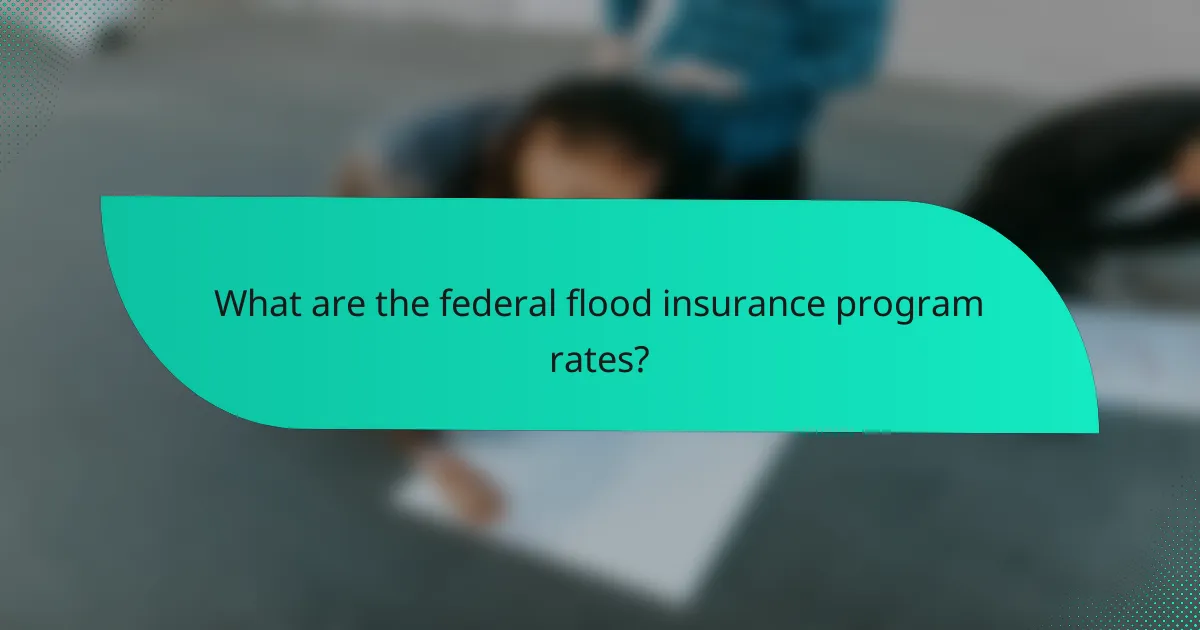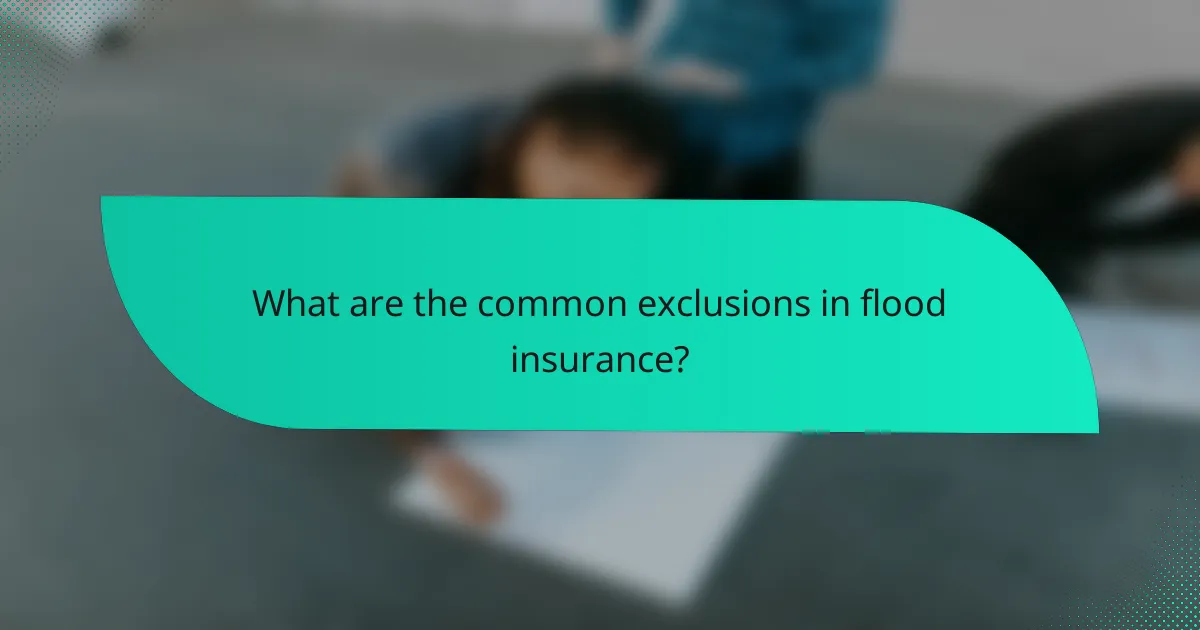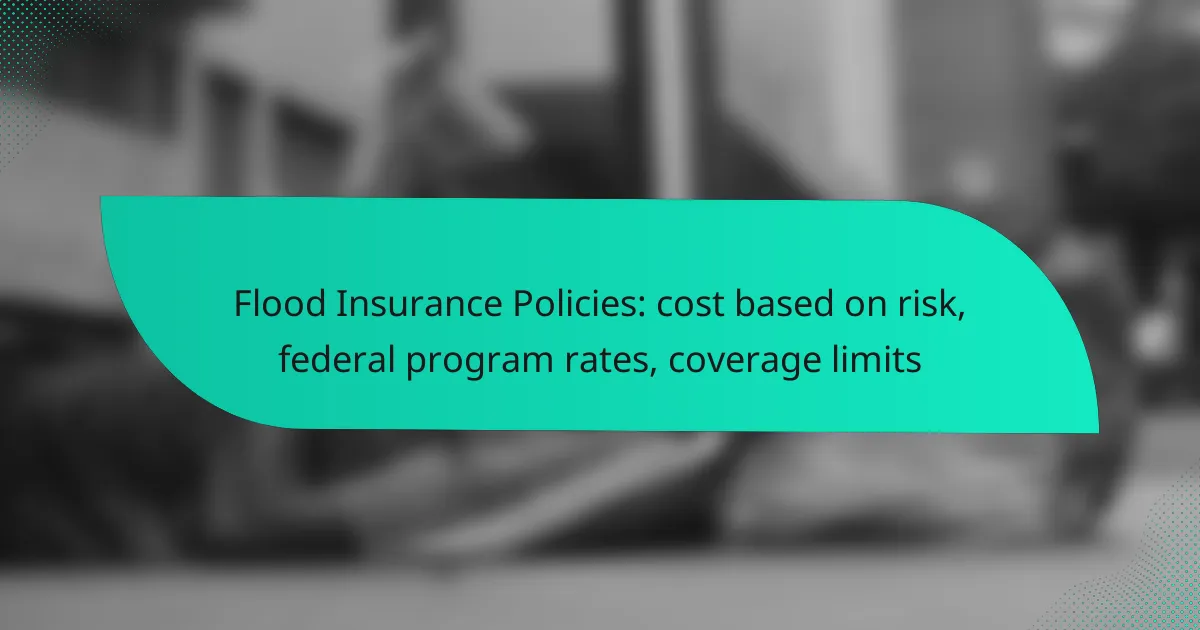Flood insurance costs are primarily determined by the risk level of a property, with higher risk areas facing steeper premiums. The National Flood Insurance Program (NFIP) establishes federal rates that aim to balance affordability with the program’s financial sustainability. Coverage limits can vary, but NFIP policies typically offer up to $250,000 for structures and $100,000 for personal belongings.

How much does flood insurance cost based on risk?
The cost of flood insurance varies significantly based on the risk level associated with a property. Higher risk areas typically incur greater premiums due to the increased likelihood of flooding, while lower risk zones enjoy more affordable rates.
Cost factors for flood insurance
Several factors influence the cost of flood insurance, including the property’s elevation, proximity to water bodies, and the structure’s age and construction type. Additionally, the coverage amount and deductible chosen will affect the premium. Properties in designated flood zones often face higher rates due to the increased risk of flooding.
Insurance companies may also consider historical flood data and local climate patterns when determining costs. Understanding these factors can help homeowners make informed decisions about their flood insurance needs.
Average premiums by risk level
Average flood insurance premiums can range from a few hundred to several thousand dollars annually, depending on the risk level. For low-risk areas, premiums may be in the low hundreds, while moderate-risk zones could see costs in the mid-hundreds to low thousands. High-risk areas often face premiums exceeding a thousand dollars.
For example, a property in a high-risk flood zone might pay between $1,500 and $3,000 per year, while a property in a low-risk area could pay around $500 or less. These averages can vary based on specific local conditions and insurance providers.
Impact of location on pricing
Location plays a crucial role in determining flood insurance pricing. Properties situated in coastal regions or near rivers are generally at higher risk and thus face steeper premiums. Conversely, homes located further inland or in elevated areas may benefit from lower rates.
Local regulations and flood zone designations, such as those established by the Federal Emergency Management Agency (FEMA), also impact pricing. Homeowners should check their flood zone status and consult with insurance agents to understand how their specific location affects their flood insurance costs.

What are the federal flood insurance program rates?
The federal flood insurance program rates are set by the National Flood Insurance Program (NFIP) and vary based on the flood risk of a property. These rates are designed to make flood insurance more affordable while ensuring that the program remains financially viable.
National Flood Insurance Program (NFIP) rates
The NFIP rates are determined by several factors, including the property’s flood zone, the building’s elevation, and the type of coverage selected. Generally, properties in high-risk areas face higher premiums, while those in lower-risk zones may benefit from lower rates. Homeowners can expect annual premiums to range from a few hundred to several thousand dollars, depending on these factors.
NFIP offers two main types of coverage: building coverage and contents coverage. Building coverage protects the structure itself, while contents coverage protects personal belongings. Homeowners can choose to purchase one or both types of coverage, impacting their overall insurance costs.
Rate changes in 2023
In 2023, the NFIP implemented changes to its rating system, known as Risk Rating 2.0, which aims to provide more equitable rates based on individual property risk rather than broader community risk. This change may lead to increased premiums for some properties while decreasing costs for others, depending on their specific flood risk profile.
Homeowners should review their policies and consider how these changes might affect their premiums. It is advisable to consult with an insurance agent to understand the implications of the new rating system and explore options for mitigating costs.
Eligibility criteria for federal programs
To be eligible for NFIP coverage, properties must be located in participating communities that adopt and enforce floodplain management regulations. Homeowners must also meet specific criteria, such as maintaining a standard policy and providing accurate information about their property.
Additionally, properties must be insurable under NFIP guidelines, which include requirements related to the building’s structure and its flood risk. Homeowners should verify their eligibility and ensure compliance with local regulations to secure coverage.

What are the coverage limits for flood insurance?
Flood insurance coverage limits vary based on the policy type and provider, with the National Flood Insurance Program (NFIP) offering specific maximums. Typically, residential properties can receive coverage up to $250,000 for the structure and $100,000 for personal belongings.
Standard coverage limits under NFIP
The NFIP sets standard coverage limits for flood insurance policies. For residential properties, the maximum coverage for the building is $250,000, while personal property coverage is capped at $100,000. Commercial properties have higher limits, with building coverage available up to $500,000 and contents coverage also up to $500,000.
It’s essential to understand that these limits may not cover all potential losses, especially in high-risk areas. Homeowners should evaluate their property value and consider additional coverage if necessary.
Additional coverage options
Policyholders can purchase additional coverage options to enhance their flood insurance. These options include Increased Cost of Compliance (ICC) coverage, which assists with the costs of elevating or relocating a structure after a flood, and coverage for basement improvements or personal property not typically covered under standard policies.
Some private insurers offer excess flood insurance, which provides higher limits beyond NFIP’s caps. This can be particularly beneficial for high-value homes or businesses in flood-prone regions.
State-specific coverage variations
Coverage limits and options can vary by state due to local regulations and market conditions. Some states may have additional programs or incentives to encourage flood insurance purchase, which can affect available coverage limits and pricing.
It’s advisable for property owners to check with their state’s insurance department or local agents to understand specific coverage variations and any additional resources available in their area. This ensures they are adequately protected against flood risks unique to their location.

How do I choose the right flood insurance policy?
Choosing the right flood insurance policy involves assessing your specific risk factors, understanding coverage limits, and comparing costs. It’s essential to evaluate your property’s flood risk and the types of coverage available to ensure adequate protection.
Key criteria for selecting a policy
When selecting a flood insurance policy, consider the level of coverage you need based on your property’s flood risk. Look for policies that cover both the structure and personal belongings, as well as additional living expenses if your home becomes uninhabitable.
Review the coverage limits, which typically range from tens of thousands to several hundred thousand dollars, depending on the policy and provider. Ensure that the policy meets or exceeds the requirements set by your mortgage lender if applicable.
Comparing private vs. federal options
Federal flood insurance, primarily through the National Flood Insurance Program (NFIP), offers standardized coverage and rates based on flood zone designations. This program typically provides coverage limits of up to $250,000 for homes and $100,000 for personal property.
Private flood insurance can offer more flexible coverage options and potentially higher limits, but rates may vary significantly based on individual risk assessments. It’s advisable to compare both options, considering factors like cost, coverage limits, and specific exclusions. Always review policy details carefully to understand what is covered and any potential gaps in coverage.

What are the common exclusions in flood insurance?
Common exclusions in flood insurance typically include damages caused by certain types of water intrusion, as well as specific property types. Understanding these exclusions is crucial for policyholders to ensure they have adequate coverage for potential flood-related losses.
Typical exclusions in policies
Flood insurance policies often exclude damages from sewer backups, surface water runoff, and water seepage through foundations. Additionally, properties located in certain high-risk areas may face restrictions on coverage for basements or below-ground levels.
Personal property such as vehicles, outdoor equipment, and landscaping are generally not covered under standard flood insurance. Homeowners should review their policies carefully to identify any specific exclusions that may apply to their situation.
Understanding flood zone designations
Flood zone designations categorize areas based on their risk of flooding, which directly impacts insurance coverage and rates. Zones are typically classified as high-risk (A and V zones), moderate-risk (B and C zones), and low-risk (X zones).
Properties in high-risk zones usually require mandatory flood insurance if they have a mortgage from a federally regulated or insured lender. In contrast, homeowners in low-risk areas may not be required to purchase flood insurance, but doing so can still be a prudent financial decision.

How can I reduce my flood insurance premiums?
To reduce your flood insurance premiums, consider elevating your property, improving drainage, and shopping around for the best rates. Implementing mitigation measures can lower your risk profile, which often leads to lower premiums.
Elevate your property
Raising your home above the base flood elevation can significantly decrease your flood insurance costs. Properties that are elevated are less likely to suffer flood damage, which insurers recognize by offering lower rates. Depending on your location, elevating your home may involve significant construction costs, but the long-term savings on premiums can be substantial.
Improve drainage and landscaping
Enhancing your property’s drainage system can help manage water flow and reduce flood risk. Simple measures like grading your yard away from the foundation, installing gutters, and using permeable materials for driveways can make a difference. These improvements not only protect your home but may also qualify you for discounts on your flood insurance.
Shop around for insurance rates
Comparing quotes from different insurance providers can help you find the most competitive rates. Each insurer assesses risk differently, so premiums can vary widely. Take the time to research and consult with multiple agents to ensure you are getting the best deal possible.
Consider the National Flood Insurance Program (NFIP)
The NFIP offers standardized flood insurance policies that can be more affordable than private options, especially in high-risk areas. Understanding the coverage limits and rates set by the NFIP can help you make informed decisions about your flood insurance needs. Additionally, if your community participates in the NFIP, you may be eligible for discounts based on local floodplain management practices.
